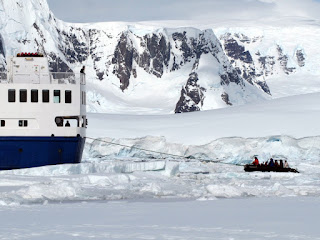
Boxing Day dawned with the first real sunshine we’d seen for more than two days. We also found ourselves anchored in a quaint, snow-smothered inlet called Dorian Bay. It’s located on the western side of Wiencke Island (that’s 64.49 degrees south) and is home to a sizable Gentoo penguin colony. Britain and Argentina also have two small huts sitting side by side near the shore.

The British hut, called Damoy Hut, is no longer in use and has since been turned into a heritage museum site. It was once a Summer base for pilots flying south with early season supplies to Rothera Base on Adelaide Island. The last residents departed in November 1993 as the British Antarctic Survey began running direct flights to Rothera the following year.
While on shore some of us, myself included, climbed up a small hill overlooking Damony Point. From here you could see the level plateau that once served as a short 400-metre ice-based landing strip for Twin Otter aircraft equipped with skids. It was hard to imagine three men living in this desolate, cold and empty wilderness for months on end.


The summit also offered the most stunning view of the surrounding snow-clad mountains (this is a phase you’ll probably hear me repeat a dozen times before my Antarctic posts are completed). The scene only grew in majesty as the sun broke through the clouds bathing more and more of the nearby mountain ridges in golden sunlight. The experience was so breath-taking I almost wept. I was also prompted to capture a brief 360 panorama video which I’ve attempted to attach to this post. If you can see it then I’ve successfully conquered the technical hurdles associated with posting a video.
After lunch we sailed further south towards Antarctica’s world famous Lemaire Channel. This is a narrow 12 kilometre channel, barely 800 metres wide that’s framed by dramatic soaring peaks. It’s often called the Kodak Gap thanks to its stunning beauty. Unfortunately, as we approached the channel it became clear that the way was blocked by heavy pack ice. Our ship was a purpose-built ice-strengthened vessel but not an ice-breaker and so the captain decided not to tempt fate.

As a consolation, we sailed around the western fringe of Booth Island. The eastern shore of this picturesque land mass makes up the western side of the Lemaire Channel. We eventually travelled as far south as Charcot Cove. The cove gets its name from a French explorer who became the first person to winter here for the first (and only) time in 1905. We reached approximately 65.05 south before swiftly moving pack ice blocked our way. This became the southernmost point we ultimately ventured during our Antarctic cruise.



At one point our guide rode the zodiac up on to an ice flow and invited us to step “ashore”. For more than ten minutes we stood on the ice watching penguins dive into the surf while soaking up the ice-filled scene around us. I can now claim to have stood on an iceberg more than 65 degrees south. The photo posted here is my proof (that's me waving in the bright blue jacket)!
Shortly after this encounter our guide’s radio began crackling with a burst of transmissions. We soon heard that three other zodiacs had become trapped in the moving pack ice. After struggling to free themselves each boat eventually radioed for help from our cruise boat. The big ship then carefully made its way through the pack ice to free each trapped boat, with the exception of my own. It took our boat more than an hour to make its way through a channel that had become blocked by pack ice in the time we’d been on the water.

Each guide later claimed it was the first time they’d ever been stuck in pack ice. I must admit I did wonder if the entire event had been planned for our entertainment. Regardless the experience was a sobering demonstration of how easy it was for the ships of early explorers to become trapped in pack ice, thus dooming their crews to a winter in Antarctica. I now have a far healthier respect for the danger these pioneers faced and the power of nature in the polar regions.
Read on to share the moment we finally set foot on the world's seventh continent.
Read on to share the moment we finally set foot on the world's seventh continent.






No comments:
Post a Comment